Wisconsin’s Aging and Disability Resource Center offices are required to submit a report on aging, including program goals, every three years to the state Department of Health Services.
Door County’s ADRC drafted a 2025-2027 report and the HHS board and the ADRC reviewed it at a Sept. 16 joint meeting between the two organizations. The meeting also functioned as a public hearing for the report.
ADRCs are part of a program directed by the state and every county has an ADRC office that serves their population, with some smaller counties sharing one between them.
According to ADRC Director Jennifer Fitzgerald, the report is intended to guide the office’s growth. It looks at local residents’ needs surrounding aging, “using a combination of population trends, community feedback, and putting it all together to move forward,” she said.
A survey of seven questions was drafted by the ADRC board and distributed as widely as possible among members of the senior community in Door County, Fitzgerald said. The ADRC received 164 responses to the survey. An additional 52 respondents participated in five “community conversations” facilitated by ADRC board members at nutrition program meal sites around the county, she said.
The ADRC took the responses and input it collected and identified population trends and issues. The trend that stood out the most, Fitzgerald said, is the rapid expansion of the aging population in Door County. This is a national trend, but because of Door County’s already high population of older residents, the rise is steeper here.
According to data presented in the ADRC’s report, half of Door County’s population will be older than 60 by 2030.
A complication to that trend is that the number of people with dementia is also growing, Fitzgerald said. By 2030, 18 percent of individuals older than 65 in Door County will be experiencing dementia, according to the report.
The ADRC is trying to get ahead of challenges represented by these trends—such as lack of housing and caregivers, and other resource scarcity—by providing education, Fitzgerald said. Familiarizing individuals, family members and caregivers about the progression of dementia and help available is a first step toward meeting the challenges of a growing aging population, she said.
“We need to maintain the resources we already have and provide more,” Fitzgerald said, and the ADRC is already feeling some pressure on meeting the needs of seniors within the current demographics.
One of the requirements of the three-year report is that the ADRC focuses on the tribal group closest to Door County and provides networking and resource support. The Native American population in Door County is very small, representing only 2.57 percent of the total population, according to report data. The ADRC will work with the Oneida Nation to fulfill the requirement. It is a federally recognized tribe of Oneida people in Wisconsin, and the reservation spans two counties west of Green Bay.
Fitzgerald described the involvement with the Oneida Nation as a “sharing exercise.”
“We teach them something we do here in Door County, and they share things they do with us,” she said.
The ADRC hopes to incorporate indigenous foods, history and traditions into some of its nutrition and cultural programming and will be scheduling quarterly peer-sharing calls between the tribe, the ADRC nutrition team and other members of the Door County aging community.

Using all of the criteria and responses, the ADRC report formulated other specific goals, Fitzgerald said, and those goals are to be built around the ADRC’s required areas of focus:
supportive services, the nutrition program, evidence-based health promotion and caregiver support.
One of those goals is to provide one to two day trips each month for Door County seniors. Addressing the issue of social isolation, groups of seniors will be invited to plan trips and activities they may be interested in but are reluctant to attempt on their own, Fitzgerald said.
Though the day trips would not be for running errands per se, she said a bonus may be that more seniors will use transportation resources available through Door-Tran, a nonprofit organization providing public transit in Door County. If more seniors are exposed to public transit resources, they will become knowledgeable and comfortable with using them more frequently, Fitzgerald added.
Expanding evidence-based health programming is another goal of the plan. The ADRC will hold classes focused on health issues members of the aging population identified as areas of interest: arthritis, brain health/dementia, eating well, and fall prevention.
A lot of these classes are located in or near Sturgeon Bay, Fitzgerald said, but the ADRC has been working toward providing more options for seniors in northern Door County, including Washington Island and southern Door County.
“We know traveling forty-five minutes for an exercise class isn’t reasonable for most seniors,” she said.
The ADRC partners withDoor County Public Health and the UW-Extension office to provide staff for programs outside of Sturgeon Bay, she said, and most of the classes, workshops, and events that do not fall under the evidence-based health category are run by volunteers.
The ADRC had 160 volunteers and roughly 8,000 volunteer hours in 2023, according to Fitzgerald. Most of those volunteers are of retirement age, but there are younger people getting involved and the ADRC wants to continue to foster intergenerational programs, she added.
ADRC programming is well-attended, Fitzgerald reported, especially the evidence-based classes. The Wisconsin Institute on Healthy Aging provides guidelines for the number of participants to make a class successful, and often the classes reach the cap on attendees.
After the public hearing on Sept. 16, in which there were no public comments, HHS approved the three-year plan. Next it will move back to the ADRC board and county’s nutrition advisory board for final revisions before being submitted to the state on Nov. 3.
Fitzgerald said the ADRC is still accepting public input on the plan.
“We really tried to listen to everyone that did share their input,” she said. “We want to grow and we want our people to grow, too, (and) learn new things. We also want the plan to be realistic.”
Statewide ‘modernization’ plan
Wisconsin’s Office for Resource Center Development, in accordance with the Department of Health Services, is working on what it calls a modernization plan for all Aging and Disability Resource Center offices statewide. The state plans to use Covid relief funds under the American Rescue Plan Act to implement the changes required by the plan.
Marketing changes include using the current ADRC logo in darker blue and adding a new tagline, “Your Bridge to Support,” according to an email from DHS to Door County officials.
Statewide, ADRC offices were implemented in 2012, and according to DHS, there are 51 ADRC offices and six Tribal Aging and Disability Resource Specialists (ADRS) in Wisconsin.
In his report at the Sept. 16 meeting, HHS Director Joe Krebsbach said Wisconsin ADRC and ADRS offices were each offered a $10,000 marketing grant this summer to use for reprinting and implementing any marketing changes needed for the plan to take effect.
Counties pushed back on the plan, including Door County, Krebsbach said, as $10,000 is not enough to cover the changes required.
Door County HHS responded to the state with an estimate of $36,000 that more realistically reflected the costs of following the modernization plan’s requirements and changing all the ADRC’s marketing materials, according to Krebsbach.
“We thought it was going to end there,” he said.
Instead the state came back with three choices for counties: receive no money, receive the originally suggested $10,000, or receive all the money their estimate determined they would need to make the changes.
The board voted unanimously in favor of the third option, but the situation left ADRC and HHS leaders questioning the state’s plans.
The ADRC logo has undergone a few changes in the last 12 years, according to Fitzgerald, and raising public awareness about the organization is already a challenge.
“We don’t want people to be more confused about who we are and what we do,” Fitzgerald said. “Of all the stuff they’d use that money for, let’s use it for something helpful, not color changes and wording.”
HHS is preparing to distribute $1,489,000 in ARPA funds to 51 ADRCs and six tribal nations with grants ranging from $6,500 to $200,000 based on local agencies’ requests for marketing changes, according to an email from Elizabeth Goodsitt, DHS communications specialist.
Some of the ARPA funds allocated to the ADRC modernization plan will go to advertising the organization and its services on TV, radio and billboards statewide, and that part of the plan is not a bad idea, Krebsbach said.
“As more of our population ages, we want them to know about the resources, we want them to know about us,” he said. “But the rebranding part is crazy to me. The taxpayer in me thinks this is nuts. Who cares what color blue it is?”
The funding distributed to 57 ADRCs and Tribal Nations can be used for any marketing or outreach materials ADRCs may want to replace or repair, Goodsitt said. This could include signage, vehicle wraps, printed brochures, newsletters, event materials, promotional items, billboards, advertising, digital media displays and more.
The state is asking local ADRCs to substitute a “gently modified logo” with increased color contrast that improves its legibility for people with visual impairments and to consider opportunities to use the new tagline when they replace or purchase new marketing materials, Goodsitt said.
“We are not moving forward with an ADRC rebrand,” she clarified in the email.
Krebsbach said one of his motivations for voting to take the maximum amount the state is offering is fear that if HHS does not, the state would mandate the changes anyway and then they would have to be paid for with local tax dollars.
Both Fitzgerald and Krebsbach emphasized the Door County ADRC would not be scrapping all its existing materials with the current logo when the changes take effect. When the office needs to replace flyers, brochures, business cards, and signage, it will use the new branding and the money from the state at that time.
Goodsitt agreed in her email: “We certainly do not expect ADRCs to discard materials that remain accurate and are in good repair.”
Other parts of the state’s modernization plan include building a centralized aging and disability resource directory, development of a client tracking and reporting system for use by ADRCs statewide, and some improved publications for use by ADRCs in their counseling of customers, among other things. These initiatives have been approved by the Centers for Medicare and Medicaid Services, Goodsitt said.
Improved technology in particular will equip ADRCs to serve more people as the population grows, she added, and increase ADRCs visibility, which saves taxpayers more money in the long run.
Every dollar invested in the program results in a savings of $3.88, according to data presented in a 2023 HHS report on ADRCs. The savings is calculated based on hospital readmissions and emergency department visits.

